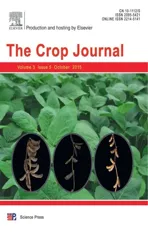Brief Guide for Authors
2015-02-11
Brief Guide for Authors
The Crop Journal is a bimonthly scientific journal co-sponsored by the Crop Science Society of China and the Institute of Crop Science, Chinese Academy of Agricultural Sciences and China Science Publishing & Media Group Ltd. Published by Elsevier and Science Press.
General Requirements
Contributions submitted to The Crop Journal must be original works of the author(s) that have not been previously published or simultaneously submitted to any other journals. The experiment related to crop yield should be conducted at least two locations or growing seasons with replications. All the results should be supported by appropriate statistical analyses.
Scopes
· Crop Germplasm Resources
· Crop Genetics, Genomics and Molecular Biology
· Crop Breeding
· Plant Bioinformatics and Biomathematics
· Plant Protection and Pathology
· Crop Physiology and Crop Management (or Agronomy)
· Cropping System and Conservation Agriculture
· Grain Chemistry, Grain Storage and Processing
Editorial Review and Acceptance
Article acceptance for publication will be solely based on the quality and originality of the research and its significance to science and technology. All manuscripts will be peer-reviewed by two or more anonymous reviewers, and the final acceptance or rejection will be decided by the Editorial Board. Authors are encouraged to suggest three to five qualified reviewers. Final decisions on manuscripts will be made within three months of submission. Papers are usually published in chronological order of acceptance.
Preparation of Manuscripts
The manuscripts should be formatted in Microsoft Word. All pages should be numbered consecutively in the bottom right-hand corner, beginning with the title page.
Manuscripts in general should be organized in the following order:
· Title
· Name(s) of author(s)
· The institutions at which the work was carried out and their postal addresses
· Abstract (200-300 words) followed by 4-7 keywords
· Introduction
· Materials and Methods
· Results
· Discussion
· Conclusions (optional)
· Acknowledgments
· References
Title should be clear, descriptive and specific. On the footnote of the first page, E-mail addresses and full telephone numbers of the corresponding author and/or the first author should be provided. Acknowledgments should contain financial support to the research including the name of funding source and its granted number, the contribution of colleagues or institutions, etc.
All measurements must be in SI or SI-derived units.
Abbreviations should be used sparingly — only where they ease the reader's task by reducing repetition of long, technical terms. Initially spell the term in full, followed by an abbreviation in parentheses, and use the abbreviation thereafter.
Upon its first use in the title, abstract, text and materials and methods, the common name of a crop should be followed by its scientific name (genus, species and authority) in parentheses. However, for well-known species, the scientific name may be omitted from the title.
The references should only include works that have been published or accepted for publication. Unpublished data and “personal communications” should not be listed in the references but may be mentioned in the text. References cited in the text should be numbered in the order of citation. All authors' names should be listed in the reference. If the works are not published in English, the actual language should be indicated in parentheses.
Examples:
[1] J.L. David, M. Zivy, M.L. Cardin, P. Brababt, Protein evolution in dynamically managed populations of wheat: adaptive responses to macro-environmental conditions,Theor. Appl. Genet. 95 (1997) 932-941.
[2] J. C. Yang, P. Wang, L.J. Liu, Z.Q. Wang, Q.S. Zhu, Evolution characteristics of grain yield and plant type for mid-season indica rice cultivars, Acta Agron. Sin. 32 (2006)949-955 (in Chinese with English abstract).
[3] L.T. Evans, Crop Evolution, Adaptation and Yield,Cambridge University Press, New York, 1993.
[4] F.G.H. Lupton. Physiological bases of heterosis in wheat.
in: A.Janossy, F.G.H. Lupton (Eds). Heterosis in Plant
Breeding, Academic Press, New York, 1974, pp 71-80. Tables and Figures
All tables and figures should be cited in the text, and numbered according to their sequence in the text. For the convenience of reviewers, the tables and figures should be arranged together with the main text document (see the sample). Once the manuscript is accepted by the Editorial Board, high-resolution photographs should be provided for publication.
Other requirements for tables:
· Each Table should have a brief and self-explanatory title.
· Column headings should be brief, but sufficiently explanatory. Standard abbreviations of measurement units should be given in parentheses.
· Tables should be prepared with the table feature in word processor, instead of using tabs, spaces or graphics boxes.
· Extra space should be given between columns, instead of using vertical lines to separate columns .
· Any explanation essential to understand the table contents should be given as a footnote at the bottom of the table.
Other requirements for figures:
· Each figure should have a brief and self-explanatory title.
· Photographs and drawings for graphs and charts should be prepared with clear contrast of black and white.
· Line width or size and symbols should be sufficient for clarity of figure contents.
· It is preferred for photographs, especially color ones to be grouped into one or more plates. The maximum length and width are 240 mm (not including the caption) and 170 mm,respectively for a full page.
· Legends should be concise and comprehensive, i.e. the plate and its legend must be understandable without reference to the text, including definitions/explanations of any symbols, abbreviations and units of measurements mentioned in the plate.
· Graphs and diagrams should be drawn with computer.
Submission of Manuscripts
Manuscripts should be submitted through Elsevier Editorial System (http://ees.elsevier.com/cj/).
Publication fees and hard copy:
All accepted papers will be published free of page charges including color figures. At least two free hard copy of the Journal for each published article will be shipped to the author.
